Food & Drink
How Jesse Sandlin Became One of Baltimore’s Top Chefs
Some 15 years—and a score of restaurant jobs—after appearing on reality TV, Sandlin has found her own sort of fame on a local level.
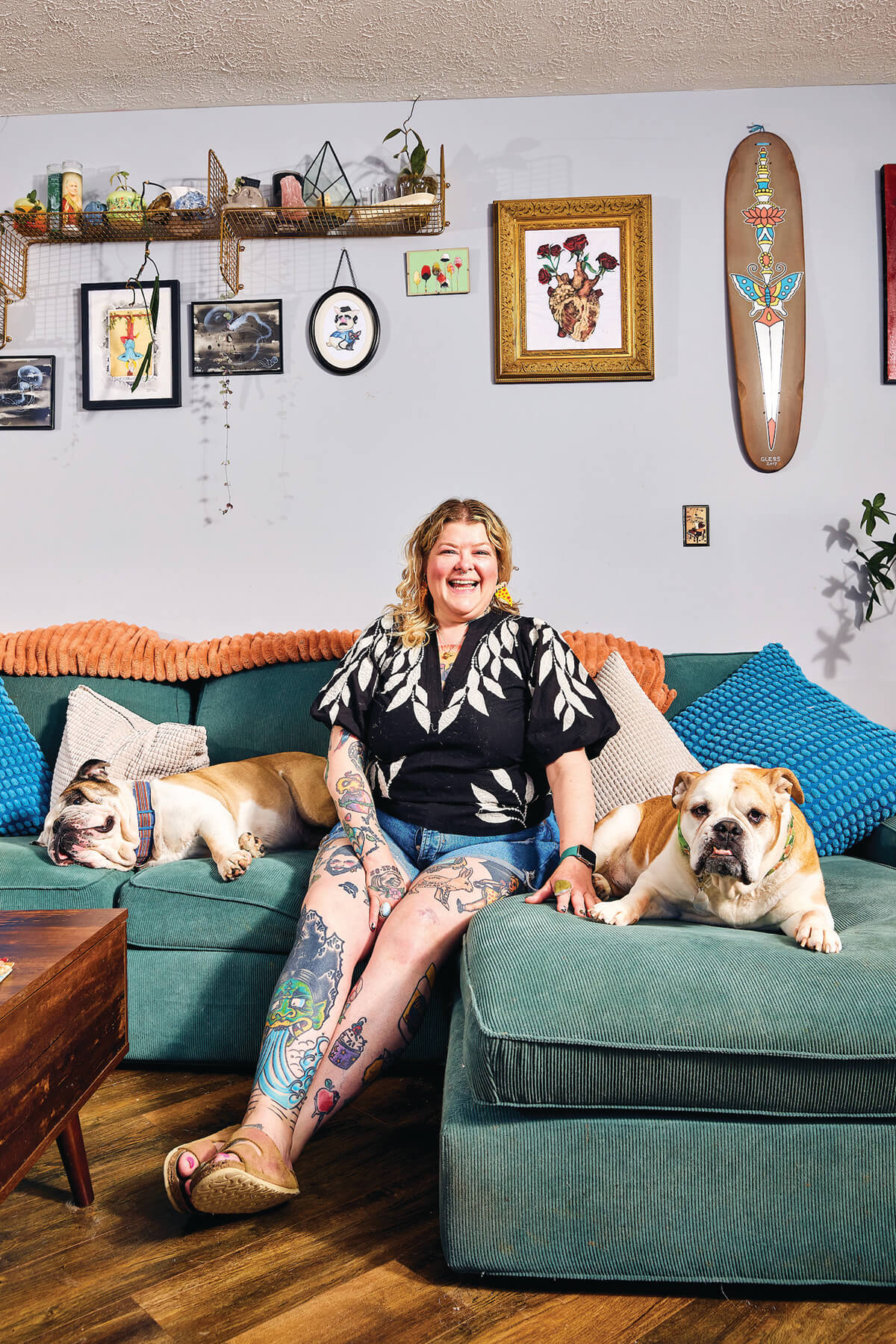
On a late winter Monday, Jesse Sandlin enjoys a rare day off. Lately, she’s been trying to take more time for herself, which hasn’t exactly been easy now that she’s the owner of three restaurants. She readily admits that she thrives on chaos—still, at 45, after 30 years in hospitality, she knows it’s time to slow down.
“I’m getting older,” says Sandlin. “I can’t do it like I used to, but I feel so much guilt if I’m not working. There has to be a better way—I don’t want to die on the line at 55.”
But even in her off time, away from the commotion of her kitchens—Bunny’s Buckets & Bubbles in Fells Point, Sally O’s in Highlandtown, and The Dive in Canton—there’s still plenty to maintain in her East Baltimore home, where there’s more than one of just about everything (except for her).
There are cookbooks along with bric-a-brac—dozens of Buddha heads, a collection of of vintage Carnival glass, various pieces of taxidermy, as well as a jungle’s worth of tropical plants—some 200 hoya, philodendron, anthurium, and orchids hang in the windows and crowd into greenhouse cabinets in her living room and basement.
While she’s the only human in the house, she lives with a veritable Noah’s Ark of animals, including two English bulldogs, Dozer and Holly, who take up most of the real estate on her emerald-green living room sofa, and two 150-pound litter-box-trained Juliana pigs, Olli Speck and Dylan Fernet (aka Fernie), who occupy an upstairs bedroom and sleep on a queen-sized bed with an electric blanket. There’s also a cat named Ivey Magnolia, who lounges on her own bed in the basement.
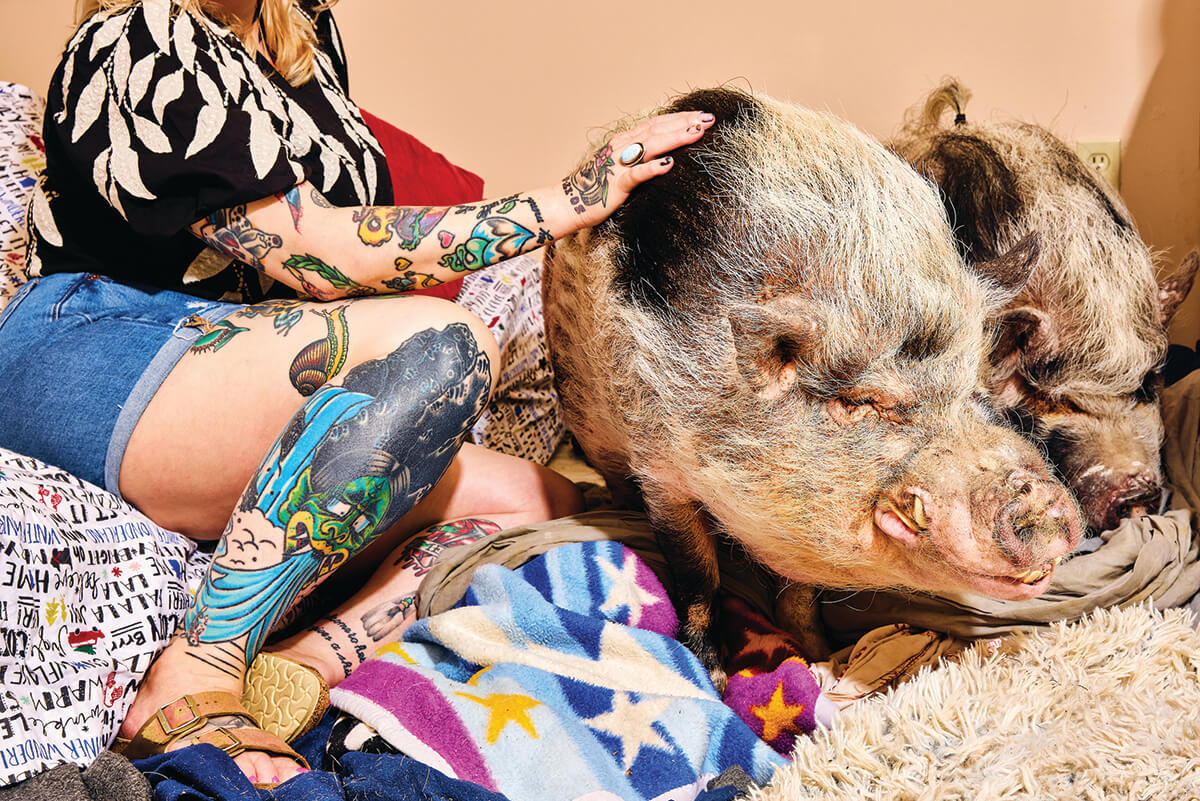
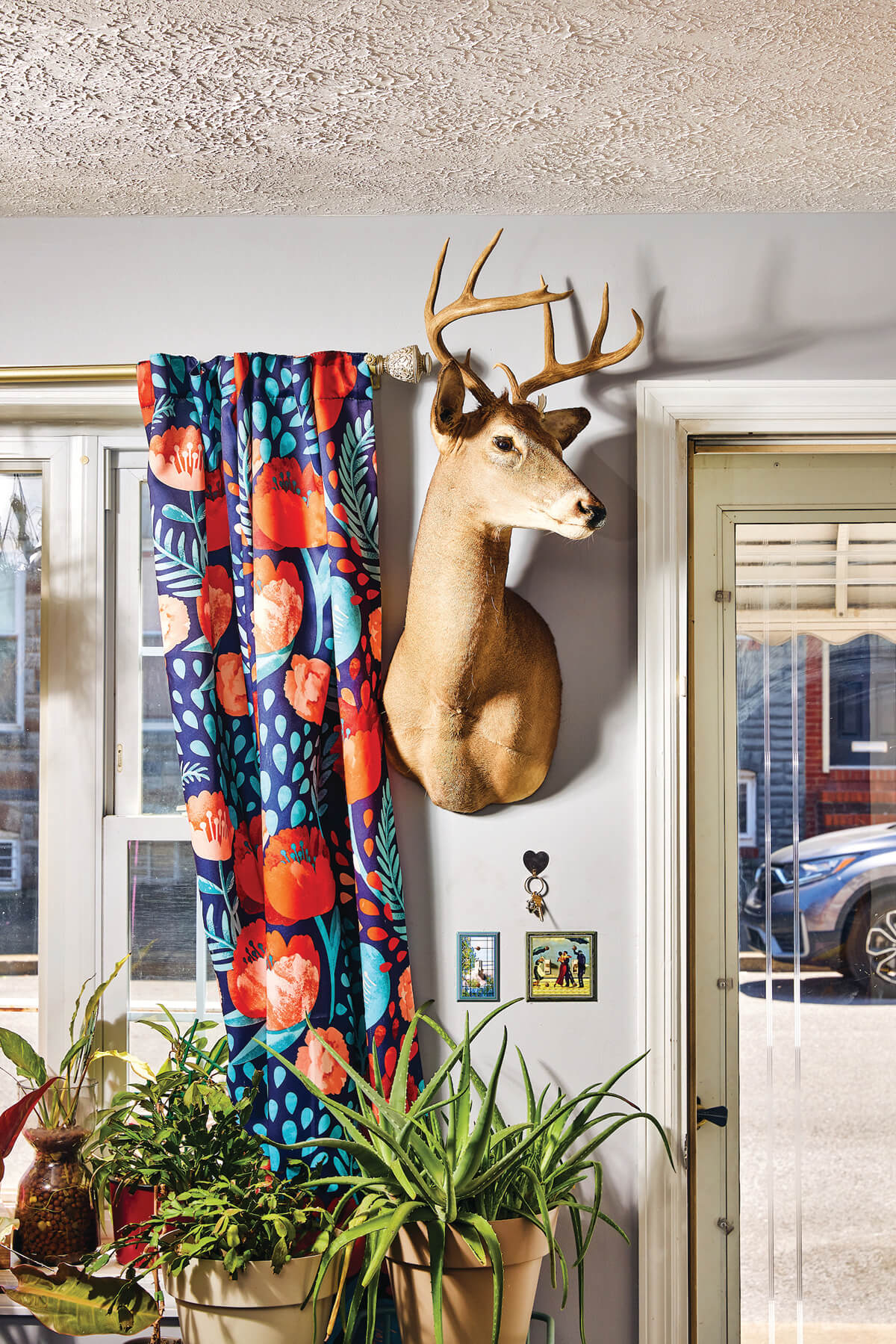
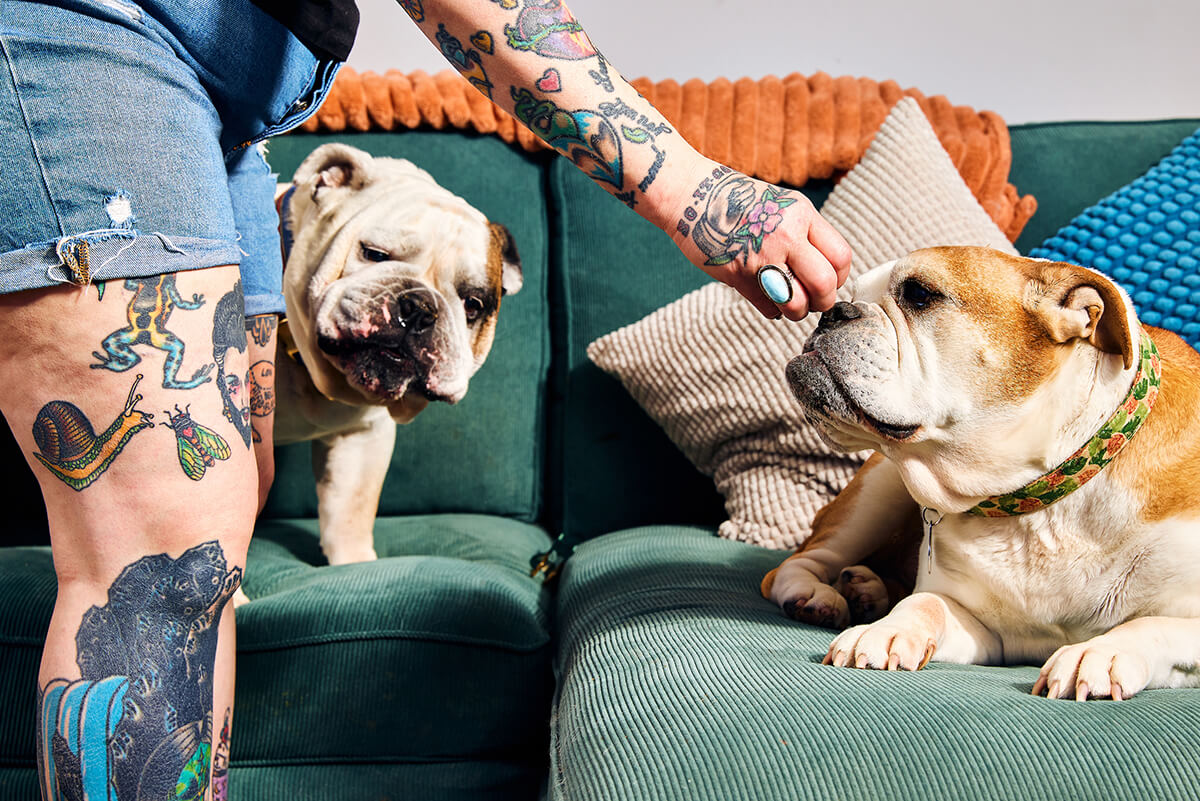
In addition to tending to the plants and pets on her days off, Sandlin watches true crime shows and naps next to the bulldogs on the sofa, while a robotic Roomba roams the floor picking up pet hair. And while Sandlin’s version of slowing down would be anyone else’s idea of busy, she says it has taken a long time for her to even get to this more medium speed.
“At some point, years ago, someone asked me, ‘If you weren’t in restaurants, what would you do?’” she says. “And I was like, ‘I don’t know, I’ve been doing this for so long now.’”
Almost overnight, Jesse Sandlin became a household name when she appeared on Bravo’s Top Chef in 2009, though she was never seeking fame. She was only hoping to drum up publicity for Abacrombie Fine Foods, where she had her first post as executive chef.
Though the restaurant, just across the street from the Meyerhoff Symphony Hall in Mt. Vernon, had shown some promise with glowing early reviews, non-performance nights were empty.
“One time, I remember doing the dinner rush and hearing someone say, ‘We love the food here, we can’t wait to come back when we go to the next show in a month,’” recalls Sandlin. “And I thought to myself, ‘Do you know we’re open all the time for dinner? You don’t have to fucking limit yourself to coming at six o’clock on a Friday night!’”
So, when Top Chef’s Magical Elves production company came calling, the timing was fortuitous.
“They were looking for a strong female from the Baltimore area,” says Sandlin, “and they had already called Cindy Wolf [of Charleston] and asked her to do it. Of course, she was like, ‘No.’ But her director of operations said, ‘I think I have someone who would be really good.’”
That someone was a then-30-year-old Sandlin, who traveled to Philadelphia with an audition tape in hand to meet with casting directors.
“We made a little video of me making some scallops, riding my bike around Baltimore with friends, and drinking at the Club Charles,” she says. “I didn’t want to do it, but I thought it would help with business.”
After that, it was off to LA to meet the Top Chef producers—and in 2009, she was cast in the show’s sixth season.
The experience, however, was more bust than boom. Sandlin finished at the bottom of the first four episodes and was eliminated in episode four, over a one-bite amuse-bouche, then had to stick around for the duration of the show, which taped in Las Vegas in the blazing heat of summer. Her parting on-camera words during her exit interview? “The thing I want people to know is that I don’t suck this bad.”
To make matters worse, it did not end up giving a boost to her restaurant back in Baltimore. By the time the episodes aired, her dad was gravely ill. After his death, a grieving Sandlin took some time to herself, headed to Australia, and never went back to Abacrombie, which closed in 2007.
The sting from that part of her life still lingers. “I used to wish I had never done Top Chef,” says Sandlin, her eyes watering at the memory. “I had no idea of the mental toll that it would take, but the editing makes it look so great. You get there and you’re completely isolated. It’s just something I don’t talk about much. I learned that I was a terrible celebrity.”
While reality TV wasn’t where she shined, some 15 years—and a score of restaurant jobs—later, Sandlin has found her own sort of fame on a local level. It didn’t come overnight from a reality show—it has come the old-fashioned way, through a combination of grit, talent, and tenacity.
“I’m a survivor,” she says. “I’m going to do what I need to do to be okay.”
Back in Baltimore, thanks to her elevated comfort food and chef-driven corner bar fare, Sandlin has found her following and no longer needs to worry about filling seats—at Bunny’s, her latest venture, she serves 250 patrons at Sunday brunch. And Top Chef be damned, her food—both whimsical and delicious, from the pickle pizza at The Dive to her pink cornmeal hush puppies at Bunny’s—feels just right for quirky Baltimore, though her more classical items, like duck-leg confit and shrimp and grits, are equally impressive.
Now in middle age, with her pierced nose, food-themed tattoos (a stick of butter, a cheesesteak, a ham), and a propensity to drop an F-bomb into almost every utterance, Sandlin is completely—unapologetically and appealingly—herself. The chef is also refreshingly outspoken, as she weighs in on everything from the injustices of the ever-evasive James Beard Award for her many-times-nominated mentor, chef Cindy Wolf, to her struggles with her weight.
“I’m like, ‘Maybe I’ll lose weight, maybe I won’t.’ I am too old to fucking care anymore.” At the same time, she admits to being hard on herself. “Maybe it’s something I have to visit with my therapist,” she says, “but I never feel good enough. I don’t know what that’s about.”
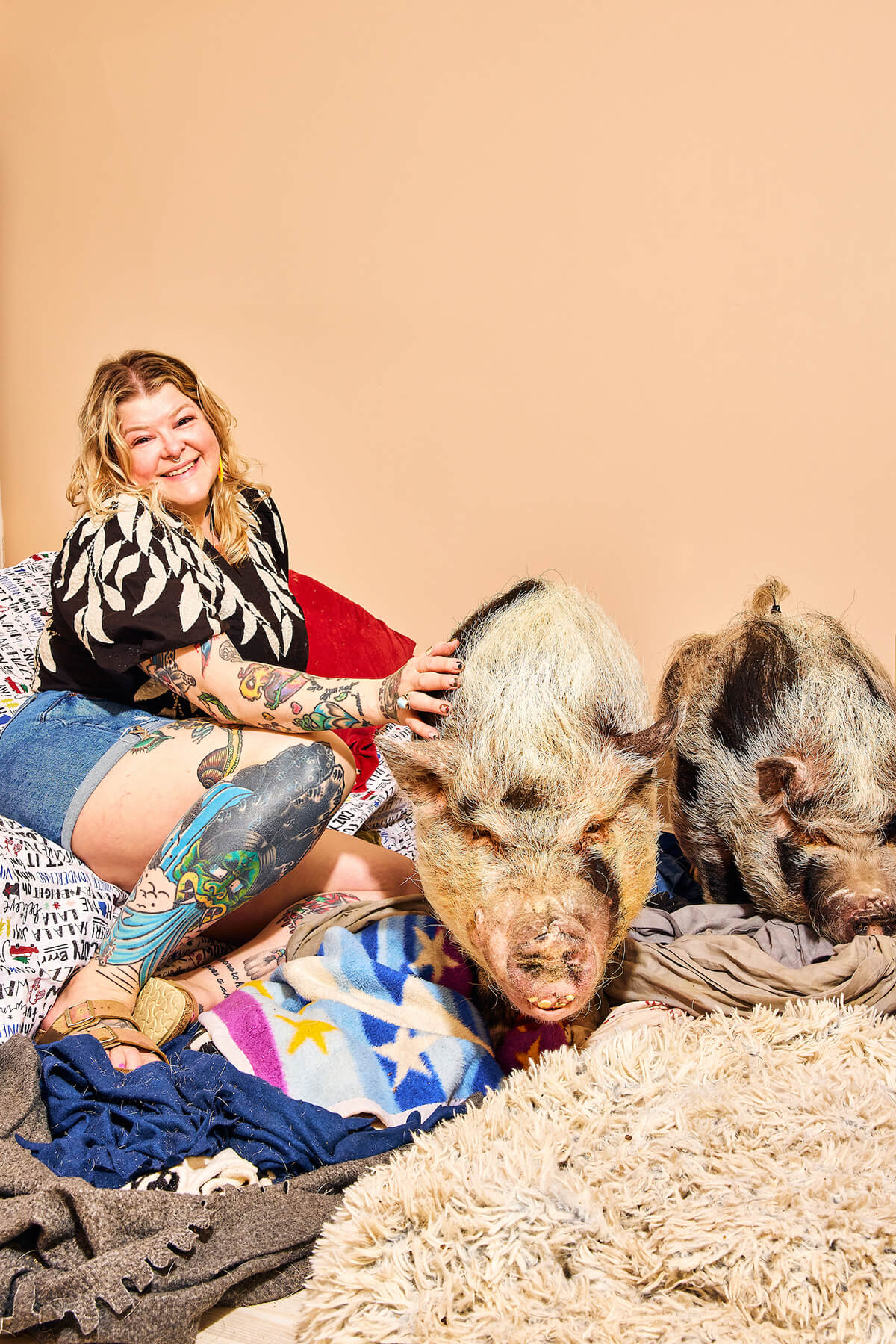
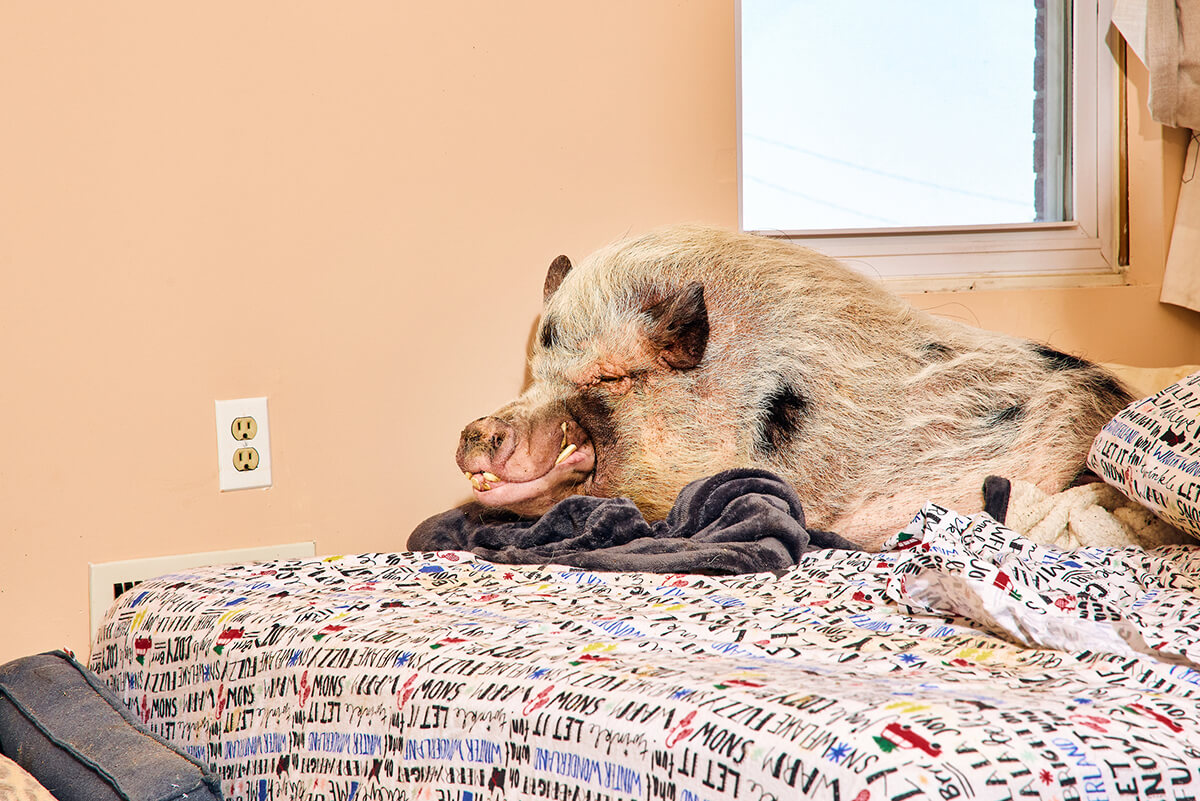
By the age of 10, Sandlin was a latchkey kid. Her single social worker mom spent long hours on the job, but money was tight.
“My mom was very thrifty,” she says, “and that came from growing up poor. On Saturdays, we would cut coupons and go to four different grocery stores.”
Typical family meals were roast chicken, Steak-umms, and Hamburger Helper. “My mom was a survivor,” Sandlin says. “There were times when she worked nights and weekends. And my dad was supposed to pay child support but he didn’t.”
Out of necessity, Sandlin learned to cook. “I’d make snickerdoodle cookies,” she says, laughing, “but it was nothing like on Master Chef Junior, where these kids are making foie gras.”
Eventually, her mom married, but family life was still strained and her stepfather was “mean and militant,” says Sandlin, who moved from Highlandtown to Dundalk to Essex and finally to Glen Burnie, where she attended high school.
In 1994, while still in high school, she landed her first job in hospitality. “I worked at a Discovery Zone, which is basically like a Chuck E. Cheese with ball pits and tunnels and they had a little area with pizza,” she says. “I was 16 and on acid. Eventually, I became the party captain in charge of the other party hostesses at kids’ birthday parties.”
From there, she took a job at Ann’s Dari-Creme, a long-running hot dog joint and something of an institution in Glen Burnie. She started as a dishwasher, before moving on to making hot dogs and taking orders.
“I learned to take orders without writing anything down,” she says. “It helped me in the long run,” she says. “You have to learn the system to remember things, which I’m really good at. That’s something that set me up to be a great line cook in the future.”
In the late ’90s, she headed to her mother’s home state of California, where she graduated from Sacramento State, then taught fifth and sixth graders in a private school. After a student ratted on her for having tattoos, she was fired from the job.
“I was like, ‘Why am I doing this? I hate mornings, I don’t like children, and I’m fucking miserable,’” she recounts. So, she went back to restaurant work. To make ends meet, she says, “For a long time, I worked two jobs—I’d work one from 8 to 3 then another from 3:30 to midnight.”
Her first high-end restaurant job was at Esquire Grill, a steakhouse in Sacramento. There, she learned to make gourmet ice cream and invented flavors like roasted banana walnut. “I’d ask the chef if he wanted to taste what I was making and he was like, ‘No, I totally trust you,’ and I was like, ‘Okay, I guess this is what I do now.’”
She was also indoctrinated into hard-driving kitchen culture.
“I was coming home when the streetlights were going off,” she says. “I was wild. We moved from daytime to nighttime and we’d all walk off the line together and sit down and have a beer, then we go to another bar together. On Thursday nights, we’d watch Dave Chapelle and go to work at 7 a.m., hungover and miserable, before Excedrin Migraine was even a thing.”
On a lark, in 2004, she traveled to Perth, Australia, and worked in a Mexican restaurant. “The food was terrible,” she says. “We served kangaroo tacos. We were so far away from Mexico, there was no authenticity whatsoever. I was like, where are the chile rellenos? Where’s the lengua?”
She lasted in the job only two weeks but stayed in Perth and worked in other local restaurants for six months or so. “It was an awesome experience but it was super isolated,” she says.
Missing her family back home, Baltimore beckoned and she was stateside again by 2005. As she headed home, she’d read about chef Cindy Wolf, co-owner/chef of Harbor East’s Charleston, in an issue of Gourmet magazine.
“I was like, ‘I’m going to move back to Baltimore and I’m going to work there,’” she says.
There were no openings at the time, but after interviewing with Wolf, she was offered a position as a line cook at Petit Louis Bistro in Roland Park, another property in the Foreman Wolf restaurant group. After a year, she made a quick jump to Spike Gjerde’s Vespa in Federal Hill, then got the call that there was an opening as a line cook at Charleston.
“I had never done food as high-end as Charleston,” she says. “And at Petit Louis, I learned those super classic French dishes. It was the first time I ever had duck confit. I learned a lot of discipline, even in how I carried myself in the kitchen, and also learned how to interact with servers just by watching that staff and the very formal brigade system.”
All the while she added to her culinary education, learning what it meant to have high standards. “As a line cook, I always knew that consistency is important but I really understood it when I went to work for Cindy Wolf, who believes that there’s no such thing as no time to do it right. It was going to be right or we were not going to serve it.”
From Charleston, she worked at Pazo, Foreman Wolf’s now-closed tapas restaurant in Harbor East. “We’d serve 1,200 people some nights. With the recommended three or four plates per person, that was almost 5,000 plates a night,” she says. “I’d come in at noon and leave at three in the morning. And on Sundays, I’d go to the farmers market with Tony Foreman at 6 a.m., still hungover after being up all night.”
From there, she was seemingly everywhere. Mt. Vernon’s Sotto Sopra, making pasta and pastry; briefly baking bread for B Bistro, Tapas Teatro, and The Helmand; and working as a line cook at Cinghiale in Harbor East. After that, she was executive chef at the Italian-leaning Vino Rosina in Harbor East, which begat an executive chef job at downhome barbecue joint Oliver Specks Eats & Drinks in the same space. Other stints followed at the corner bar Jack’s Bistro and Southern-style Jokers N’ Thieves in Canton.
Her food was innovative and elevated but the customers didn’t always care. “I was doing shrimp and grits and I made this blackened catfish with hominy and bacon and salsa verde that was fucking delicious,” says Sandlin of her time at Jack’s, “but nobody gave a shit—everyone wanted a burger.”
It was at The Outpost American Tavern in Riverside where she first found her voice in the kitchen.
“Until then, I was trying to do what I thought other people wanted,” she explains of her life as a peripatetic chef. “I started to cook food that I wanted to eat, so if there was a burger, it was a great burger, and it was on an onion roll because I love an onion roll when I eat a burger.”
Beyond burgers, there were other more chef-driven dishes, like shaved Brussels sprouts and blue cheese with candied pecans, house-made gourmet “trash can” nachos, and blackened tuna salad with pickled onions and carrots tossed in a sweet chile dressing.
In the summer of 2020, she opened her first restaurant on the site of The Laughing Pint in Highlandtown. After signing the lease for what became Sally O’s, she promptly had a meltdown.
“I sat in the pigs’ room and had a panic attack,” she recalls. She called her friend Brian Acquavella, who later became her business partner (along with Matt Akman) in the venture. “He talked me off the ledge,” she says. “He told me I’d be fine.”
And much like the style she started at The Outpost, the menu she devised was a high-low blend with something for every palate—and pocketbook.
“I wanted a true neighborhood place where you could stop in and drink a Natty Boh and eat a smashburger and wear your sweatpants,” says Sandlin, “or you could come in a nice suit and tie and get a great steak and a good bottle of wine or a cocktail. The idea was that everyone is welcome. We want you to feel comfortable and not judged—and that style of service is very Baltimore.”
Acquavella, who first met Sandlin when he owned Jokers & Thieves, has enjoyed watching her trajectory.
“Jesse started her career in the humblest place possible—cooking hot dogs—and she managed to make it into the kitchen of Foreman Wolf, the two greatest restaurateurs in Baltimore,” he points out. “She has such a broad range and is not afraid to use that. Most chefs find their lane and stay in it—Jesse has an eight-lane highway and moves side to side.”
On an unseasonably warm Wednesday afternoon, Sandlin sits in the upstairs dining room at Bunny’s, near the open kitchen. Years ago, a coworker dubbed Sandlin “Bunny,” after the sexy rabbit logo on the bag of Bunny-Luv brand carrots. She ran with it. There’s bunny artwork throughout the restaurant, which serves up serious eats with a wink. On a marquee over the U-shaped bar, there are cheeky slogans: “Some bunny luvs u” and “Nuggs & kisses.”
“You guys did a great job of selling the halibut dish last night,” says Sandlin during her menu meeting with staff. “We have five left. Now, who knows what the gnocchi prep is?”
As her cook thaws scores of biscuits and drops chicken in the Bunny’s pressure cooker behind her (they do 350 orders of fried chicken on a busy night), Sandlin sits front and center.
“We have 17 [parties] on the books tonight,” she says, “but it’s nice outside; don’t be surprised if you get a late-night rush.”
While she talks, her niece and Bunny’s staffer, Kaylee, affectionately puts her arm around her aunt—but everyone on staff is family. Once the meeting is over, Sandlin jokes with her staff about doing karaoke after work one night soon.
“Of course, I’ll do ‘Total Eclipse of the Heart,’” she says, “because it’s fucking awesome.”
After the meeting, Sandlin will organize her walk-in refrigerator, then head home to her menagerie, while Kaylee takes her place expediting during dinner service.
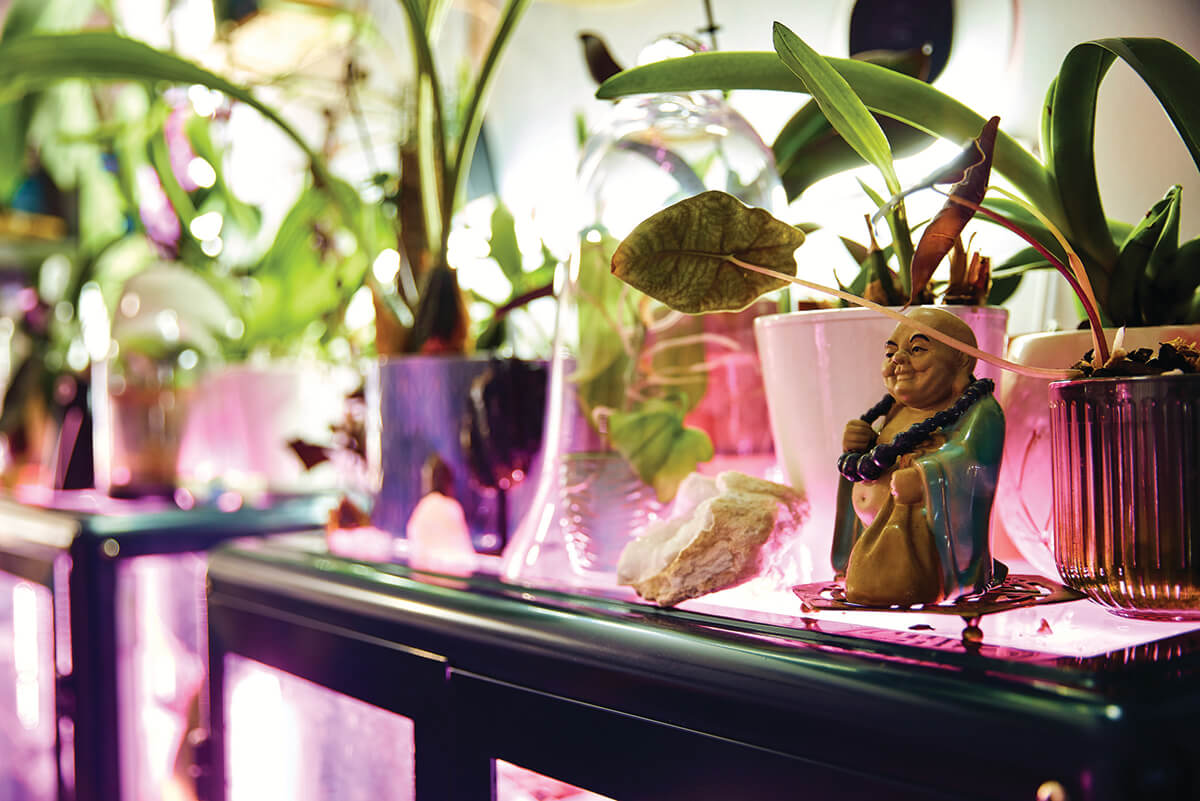
This is Sandlin setting boundaries and making more time for herself. She still enjoys nights out with her staff but she says, “I’m significantly less wild now, though I do go out and drink more than my rheumatologist would like.”
She’s come far since her early days, when money was the driving force.
“When I was working two jobs, it was just to make money,” says Sandlin. “I am happy for all the experience I got but I’d work myself to death as long as I could buy whatever I wanted—that comes from being poor as a kid. I still remember that when I was at the store with my mom, I always wanted a gumball from one of those machines on the way out and my mom would never give me a quarter for one. Now, if I see a gumball machine, I’m getting a gumball.”
Sandlin defines success differently now.
“I have employees who are happy and who really like working for me,” she says. “And I’m able to give people jobs and pay them a living fucking wage, and I’m able to treat people the way I wish people had treated me years ago.”
She’s proud of the fact that she recently treated a Bunny’s sous chef and his line cook girlfriend to a birthday meal at Marta. “I called ahead and told them to put the meal on my credit card,” she says. “I love that I could do that.”
Away from the cameras and out of the spotlight, Sandlin has redefined just what it means to be a top chef.